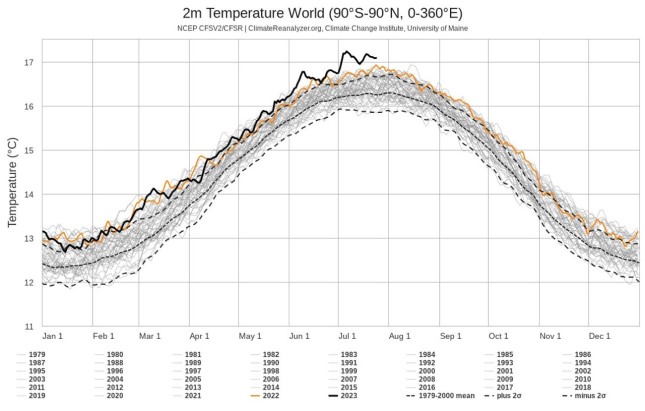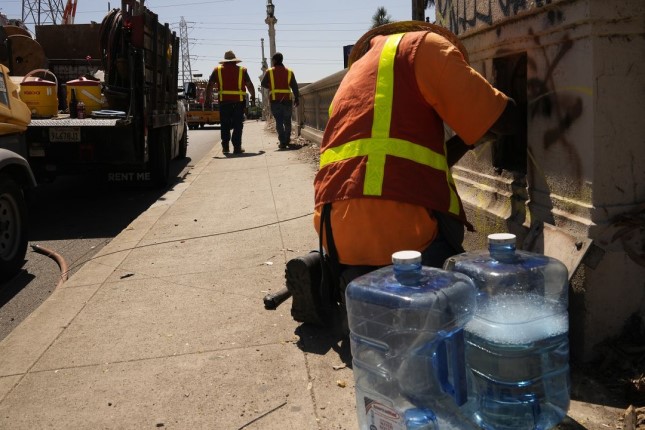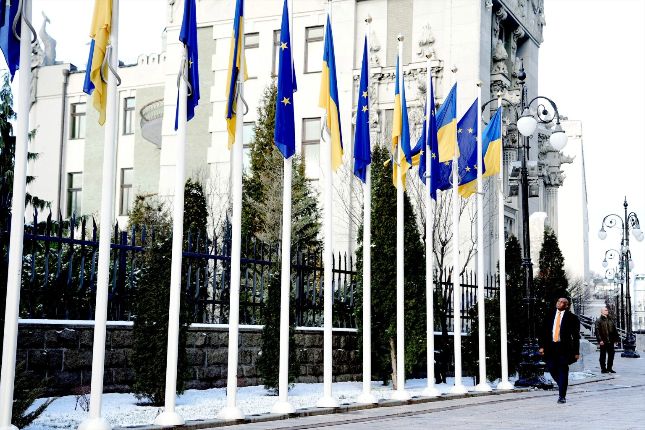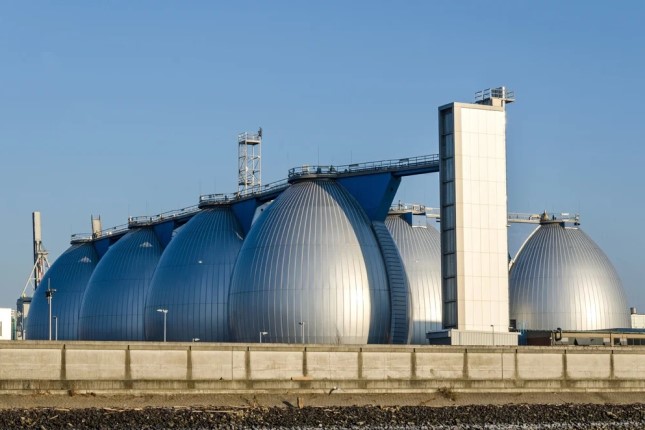As climate scientist Michael Mann explained Monday to CBS News, “As we continue to burn fossil fuels, put carbon pollution into the atmosphere we are warming the planet and are getting a little extra kick from an El Niño event…a little extra octane added to human caused climate change… the planet is warming and will continue to warm until we stop dumping carbon into the atmosphere.” He warned that, “dangerous climate change has arrived.”
For more than three weeks the average global temperature has remained above the previous hottest temperature ever recorded, 16.92 degrees Celsius (62.46 degrees Fahrenheit) seen in mid-August 2016. This measure, which averages the global temperature over 24 hours, peaked at 17.23 Celsius (63.01 F) on July 6, more than 1 degree Celsius above average, and has remained elevated with no sign of abating. The ten hottest years on record have all been experienced since 2010, with 2023 on trend to set another record.
Climate scientists at World Weather Attribution, who assess the degree to which climate change influences local weather patterns, reported Tuesday that the heat seen this month in the US and Europe would have been “virtually impossible” without the impact of human induced climate change and that extended heat waves are no longer rare thanks to continued carbon emissions.

The record global heat has been driven by temperatures which, despite remaining frigid, are up to 40 degrees Celsius above seasonal averages in Antarctica with sea ice forming at a rate slower than ever recorded in the Southern Hemisphere’s winter months. As of June, prior to the temperatures recorded this month, Antarctic sea ice was 0.9 million square miles (2.28 million square kilometers) below the average recorded between 1980-2010 for June and below the previous monthly average record low recorded in 2019.
“To say unprecedented isn’t strong enough,” Dr. Edward Doddridge, a physical oceanographer, told ABC News in Australia about the current developments in Antarctica. “For those of you who are interested in statistics, this is a five-sigma event. So it’s five standard deviations beyond the mean. Which means that if nothing had changed, we'd expect to see a winter like this about once every 7.5 million years.”
This month has witnessed the eruption of fires on the Greek islands of Rhodes and Corfu, forcing tens of thousands of residents and tourists to flee for their lives. Meanwhile wildfires continue to burn across Canada, consuming a record smashing 11.9 million hectares of land (29.4 million acres), repeatedly pushing out plumes of hazardous smoke which choked tens of millions across North America.
Meanwhile, the waters off Florida’s southern coast hit 38.38 C (101.1 F) on Monday, a new global record. At these temperatures critical coral ecosystems are bleaching, putting them at risk for disease and mass die offs. High water temperatures promote the growth of toxic algae blooms and also decrease oxygen concentration which can lead to mass fish die offs. The National Oceanic and Atmospheric Administration estimates that the impact of climate change has doubled in size the scope of oceanic heat wave forecast for September, with half of global ocean waters expected to be affected.
Multiple heat domes, ridges of stationary high pressure, remain in place over much of the United States, Southern Europe, Northern Africa, India and Asia, putting tens of millions at risk of death from baking temperatures. Prolonged high temperatures are the deadliest of weather events, killing thousands around the world every year. A study published this month in Nature Medicine found that 61,672 people died across Europe in the three hottest months of 2022 due to heat-related illnesses. With temperatures reaching 45 degrees C (113 F) this month in Italy and Greece, a similar, or worse, death toll is expected.
While the elderly and the homeless are typically the most impacted by extreme heat, there are also hundreds of millions of workers globally who must continue to labor in sweltering factories or outdoors in the sun, regardless of the conditions, putting them at increased risk of heatstroke or death. The Arizona Republic reported Monday that 26-year-old farmworker Dario Mendoza died last week after collapsing under extreme heat in Yuma, Arizona. Farmworkers are 20 times more likely to die of heat exposure than other workers, according to the Centers for Disease Control and Prevention (CDC).
While the working class and poor around the world are bearing the brunt of the effects of climate change, all the limited pledges from capitalist governments and corporations to curb emissions have been dropped just as quickly as they were signed, in favor of piling up mountains of wealth and waging war. The Paris Climate Accords adopted in 2015 with the promise of limiting global temperature increase to 1.5 degrees Celsius is but a distant memory with the actions taken since then by various governments all rendered too little and too late. The US federal government is expected to spend an average of $80 billion per year between 2022 and 2027 on climate technology and clean energy, while it will spend more than $876 billion on its military in 2022 alone, one of the largest polluters on the planet.
In effect the approach of capitalist governments to climate change is the same “let it rip” strategy taken to the pandemic. Millions, potentially billions, of deaths are the price to be paid by the working class and impoverished masses as long as the ruling elite can live in wealth and comfort thanks to the latest scientific advances. The crisis is used instead to squeeze the working class and funnel ever greater sums of money to the banks and big business. Ever loyal to profit and their national bourgeoisie, middle class environmental protest groups will continue to limit their appeals for action to the ruling class. The best example of this is the Green Party in Germany, which has become the leading party of war and an advocate for nuclear weapons.
The ongoing climate catastrophe and its immediate devastation being felt around the world makes clear that there will be no national solution to climate change. Appeals to governments and corporations are a dead end. The root of the problem is not humanity itself, as the most misanthropic environmentalists argue, but capitalism. The working class, united internationally must take action to transform social relations and establish socialism in order to confront the global challenge of climate change.
Main photo: Electricians with IBEW Local 11 pull out an old copper cable line under excessive heat from the old Cesar Chavez Avenue Viaduct in Los Angeles, Thursday, July 13, 2023 © AP Photo / Damian Dovarganes.
Source: World Socialist Web Site.
































